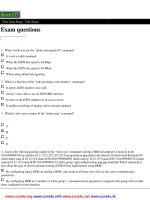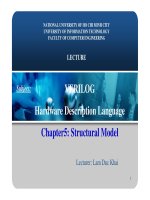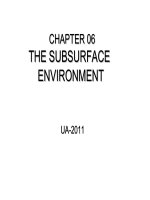Chapter5 c
Bạn đang xem bản rút gọn của tài liệu. Xem và tải ngay bản đầy đủ của tài liệu tại đây (785.51 KB, 19 trang )
Ethernet Switches
layer 2 (frame) forwarding, filtering
using LAN addresses
Switching: A-to-B and A’-to-B’
simultaneously, no collisions
large number of interfaces
often: individual hosts, starconnected into switch
Ethernet, but no collisions!
Ethernet Switches
cut-through switching: frame forwarded from input to output port
without awaiting for assembly of entire frame
slight reduction in latency
combinations of shared/dedicated, 10/100/1000 Mbps interfaces
Ethernet Switches (more)
Dedicated
Shared
IEEE 802.11 Wireless LAN
wireless LANs: untethered (often mobile) networking
IEEE 802.11 standard:
MAC protocol
unlicensed frequency spectrum: 900Mhz, 2.4Ghz
Basic Service Set (BSS) (a.k.a. “cell”)
contains:
wireless hosts
access point (AP): base station
BSS’s combined to form distribution
system (DS)
Ad Hoc Networks
Ad hoc network: IEEE 802.11 stations can dynamically form
network without AP
Applications:
“laptop” meeting in conference room, car
interconnection of “personal” devices
battlefield
IETF MANET
(Mobile Ad hoc Networks)
working group
IEEE 802.11 MAC Protocol: CSMA/CA
802.11 CSMA: sender
- if sense channel idle for DISF sec.
then transmit entire frame (no collision
detection)
-if sense channel busy
then binary backoff
802.11 CSMA receiver:
if received OK
return ACK after SIFS
IEEE 802.11 MAC Protocol
802.11 CSMA Protocol: others
NAV: Network Allocation
Vector
802.11 frame has transmission time
field
others (hearing sata) defer access for
NAV time units
Hidden Terminal effect
hidden terminals: A, C cannot hear each other
obstacles, signal attenuation
collisions at B
goal: avoid collisions at B
CSMA/CA: CSMA with Collision Avoidance
Collision Avoidance: RTS-CTS exchange
CSMA/CA: explicit channel
reservation
sender: send short RTS:
request to send
receiver: reply with short CTS:
clear to send
CTS reserves channel for sender,
notifying (possibly hidden)
stations
avoid hidden station collisions
Collision Avoidance: RTS-CTS exchange
RTS and CTS short:
collisions less likely, of shorter
duration
end result similar to collision
detection
IEEE 802.11 alows:
CSMA
CSMA/CA: reservations
polling from AP
Point to Point Data Link Control
one sender, one receiver, one link: easier than broadcast link:
no Media Access Control
no need for explicit MAC addressing
e.g., dialup link, ISDN line
popular point-to-point DLC protocols:
PPP (point-to-point protocol)
HDLC: High level data link control (Data link used to be
considered “high layer” in protocol stack!
PPP Design Requirements [RFC 1557]
packet framing: encapsulation of network-layer datagram in data
link frame
carry network layer data of any network layer protocol (not just
IP) at same time
ability to demultiplex upwards
bit transparency: must carry any bit pattern in the data field
error detection (no correction)
connection livenes: detect, signal link failure to network layer
network layer address negotiation: endpoint can learn/configure
each other’s network address
PPP non-requirements
no error correction/recovery
no flow control
out of order delivery OK
no need to support multipoint links (e.g., polling)
Error recovery, flow control, data re-ordering
all relegated to higher layers!|
PPP Data Frame
Flag: delimiter (framing)
Address: does nothing (only one option)
Control: does nothing; in the future possible multiple control fields
Protocol: upper layer protocol to which frame delivered (eg, PPP-
LCP, IP, IPCP, etc)
PPP Data Frame
info: upper layer data being carried
check: cyclic redundancy check for error detection
Byte Stuffing
“data transparency” requirement: data field must be allowed to
include flag pattern <01111110>
Q: is received <01111110> data or flag?
Sender: adds (“stuffs”) extra < 01111110> byte after each <
01111110> data byte
Receiver:
two 01111110 bytes in a row: discard first byte, continue data
reception
single 01111110: flag byte
Byte Stuffing
flag byte
pattern
in data
to send
flag byte pattern plus
stuffed byte in transmitted data
PPP Data Control Protocol
Before exchanging network-layer data,
data link peers must
configure PPP link (max. frame
length, authentication)
learn/configure network
layer information
for IP: carry IP Control Protocol
(IPCP) msgs (protocol field:
8021) to configure/learn IP
address
Chapter 5: Summary
principles behind data link layer services:
error detection, correction
sharing a broadcast channel: multiple access
link layer addressing, ARP
various link layer technologies
Ethernet
hubs, bridges, switches
IEEE 802.11 LANs
PPP
journey down the protocol stack now OVER!
Next stops: security, network management









